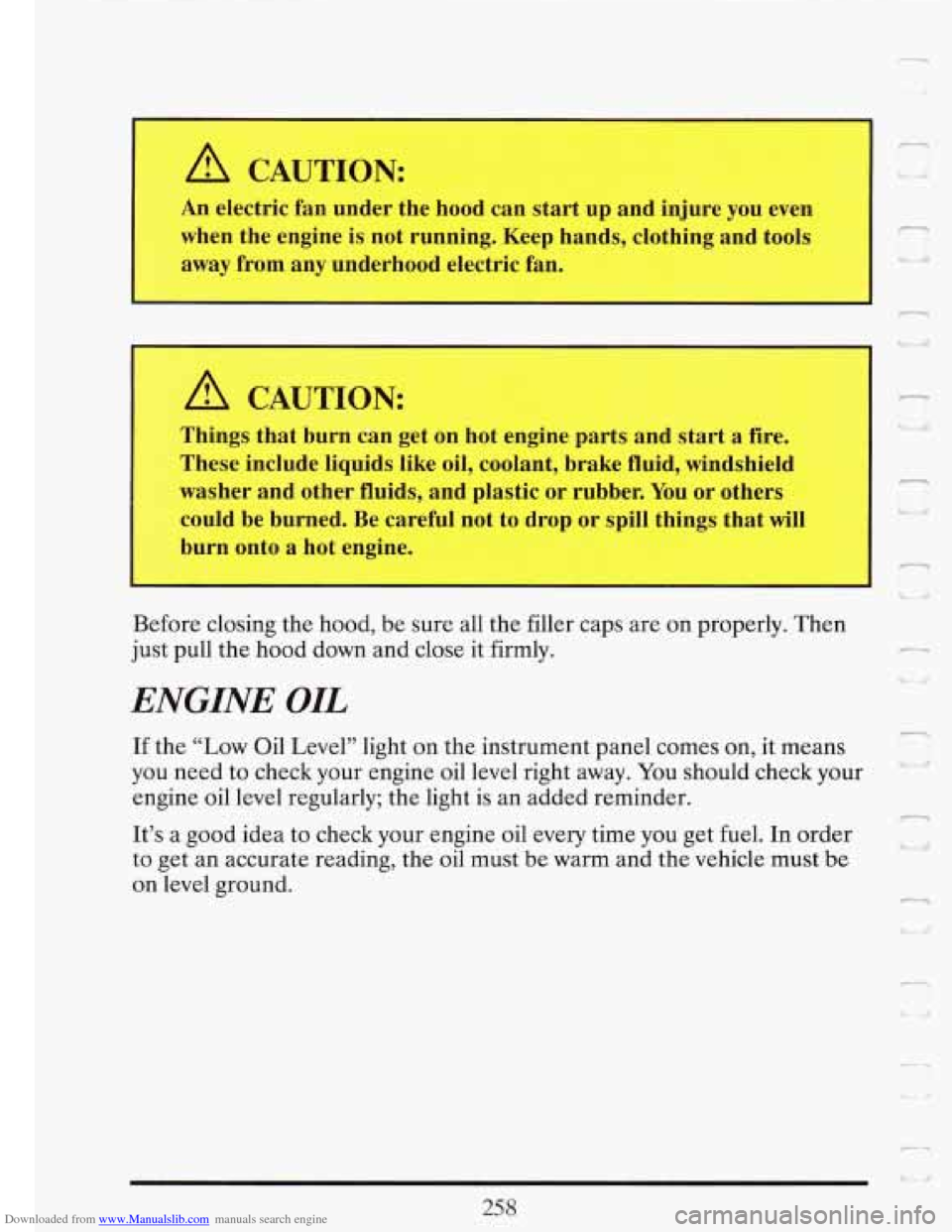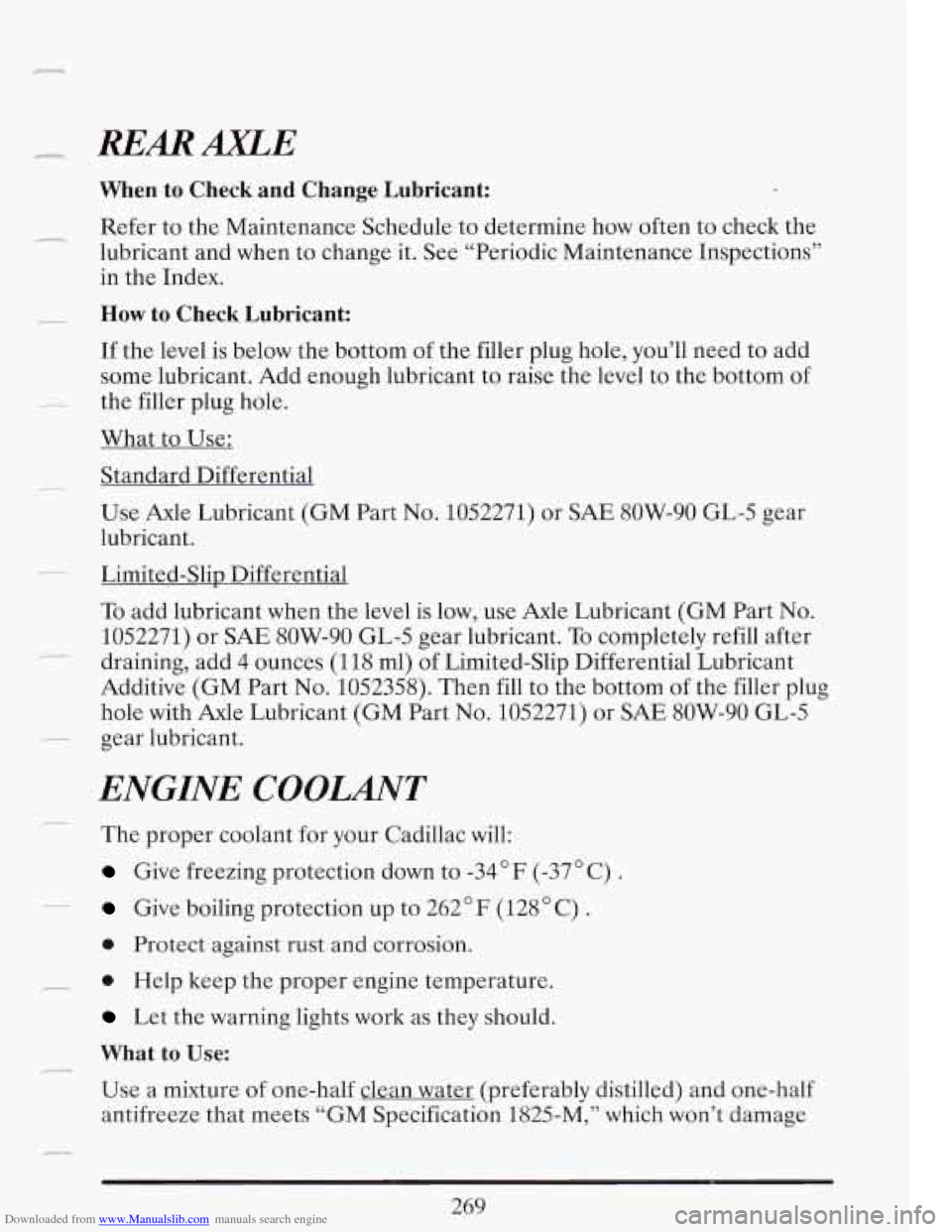Page 245 of 386
Downloaded from www.Manualslib.com manuals search engine - How to Add Coolant to the Coohnt Recovery Tank
If you haven’t found a problem yet, but the coolant level isn’t at or above
“FULL COLD,” add a 50/50 mixture of clean water (preferably distilled)
Coolant” in the Index for more information about the proper coolant
mix.)
- and a proper antifreeze at the coolant recovery tank. (See “Engine
,-
A CAUTION:
I Adding only plain water to your cooling system can be
dangerous. Plain water, or some other liquid like alcohol, can
boil before the proper coolant mix
will. Your vehicle’s coolant
water or the wrong mix, your engine could get too hot but you
wouldn’t get the overheat warning. Your engine could catch fire
water and
a pmqer antifreeze.
I warning system is set for the proper coolant mix. With plain
I and you or others could be burned. Use a 50/50 mix of clean
23 1
Page 246 of 386
Downloaded from www.Manualslib.com manuals search engine i
A CAUTION:
You can be burned if you spill coolant on hot engine parts.
Coolant contains ethylene glycol and
it will burn if the engine
parts are hot enough. Don’t spill coolant on a hot engine.
When the coolant in the coolant recovery tank is at or above “FULL
COLD,” start your vehicle.
If the overheat warning continues, there’s one more thing you can try.
You can add the proper coolant
mix directly to the radiator, but be sure
the cooling system is
cool before you do it.
T
Y
232
Page 248 of 386
Downloaded from www.Manualslib.com manuals search engine How to Add Coolant to the Radiator
You can remove the radiator pressure cap when the cooling system,
includinp the radiator pressure cap and upper radiator hose, is
no longer
hot.
- 1. Turn the pressure
cap slowly to the
left until it first
stops. (Don’t
press down while turning the
pressure cap.)
r
u
7 ‘I! U
r
U
-
If you hear a hiss, wait for that to stop. A hiss means there is still some .
pressure left.
2. Then keep turning
the pressure cap,
but now push
down as you turn
it. Remove the
pressure cap.
L
Page 250 of 386
Downloaded from www.Manualslib.com manuals search engine 5. Put the cap back
on the coolant
recovery tank, but
leave the radiator
pressure cap off.
I
6. Start the engine
and let it run until
you can feel the
upper radiator
hose getting hot.
Watch out for the
engine fans.
7. By this time the coolant level inside the radiator filler neck may be
lower.
If the level is lower, add more of the proper mix through the
filler neck until the level reaches the base of
the filler neck.
1
u
Page 272 of 386

Downloaded from www.Manualslib.com manuals search engine A CAUTION:
An electric fan under the hood can start up and injure you even
when the engine is not running. Keep hands, clothing and tools
away from any underhood electric fan.
A CAUTION:
Things that burn can get on hot engine parts and start a fire.
These include liquids like oil, coolant, brake fluid, windshield
washer and other fluids, and plastic or rubber.
You or others
could be burned. Be careful not to drop or spill things that will
burn onto
a hot engine.
I
Before closing the hood, be sure all the filler caps are on properly. Then
just pull the hood down and close it firmly.
ENGINE OIL
If the “Low Oil Level” light on the instrument panel comes on, it means
you need to check your engine oil level right away. You should check your
engine oil
level regularly; the light is an added reminder.
It’s a good idea to check your engine oil every time you get
fuel. In order
to get an accurate reading, the oil must be warm and the vehicle must be
on level ground. c1
u
Page 283 of 386

Downloaded from www.Manualslib.com manuals search engine r REARAXLE
1
When to Check and Change Lubricant:
Refer to the Maintenance Schedule to determine how often to check the
lubricant and when to change it. See “Periodic Maintenance Inspections”
in the Index.
How to Check Lubricant:
If the level is below the bottom of the filler plug hole, you’ll need to add
some lubricant. Add enough lubricant to raise the level to the bottom of
What to Use:
~ the filler plug hole.
Standard Differential
Use Axle Lubricant (GM Part
No. 1052271) or SAE 8OW-90 GL-5 gear
lubricant.
Limited-Slip Differential
To add lubricant when the level is low, use Axle Lubricant (GM Part No.
1052271) or SAE 8OW-90 GL-5 gear lubricant. To completely refill after
draining, add
4 ounces (1 18 ml) of Limited-Slip Differential Lubricant
Additive (GM Part
No. 1052358). Then fill to the bottom of the filler plug
hole with Axle Lubricant (GM Part
No. 1052271) or SAE 8OW-90 GL-5
~ gear lubricant.
ENGINE COOLANT
The proper coolant for your Cadillac will:
Give freezing protection down to -34°F (-37’ C) .
_- Give boiling protection up to 262°F (128°C) .
0 Protect against rust and corrosion.
__ 0 Help keep the proper engine temperature.
Let the warning lights work as they should.
What to Use:
Use a mixture of one-half clean water (preferably distilled) and one-half
antifreeze that meets
“GM Specification 1825-M,” which won’t damage
269
Page 284 of 386
Downloaded from www.Manualslib.com manuals search engine .aluminum parts. You can also use a recycled coolant conforming to GM
Specification 1825-M with a complete coolant flush and refill. Use GM
Engine Coolant Supplement (sealer) with any complete coolant change. ,~
If you use these, you don’t need to add anything else.
A CAUTION:
Adding only plain water to your cooling system can be
dangerous. Plain water,
or some other liquid like alcohol, can
boil before the proper coolant mix will. Your vehicle’s coolant
warning system is set for the proper coolant mix. With plain
water or the wrong mix, your engine could get too hot but you
wouldn’t get the overheat warning. Your engine could catch fire
and you or others could be burned. Use
a 50/50 mix of clean
water and
a proper antifreeze.
Page 285 of 386
Downloaded from www.Manualslib.com manuals search engine _q Adding Coolant
To Check Coolant:
When your engine is
cold, the coolant level
should be at “ADD,”
or a little higher.
When your engine is
warm, the
level should
be up to
“FULL,” or a
little higher.
To Add Coolant: If you need more coolant, add the proper mix at the
coolant recoverv tank. -.
Turning the radiator pressure cap when the engine and radiator
are hot can allow steam and scalding liquids to blow out and
burn you badly. With the coolant recovery tank, you will almost
never have to add coolant at the radiator. Never turn the
radiator pressure cap
-- even a little -- when the engine and
radiator are hot.
I
~
Add coolant mix at the recovery tank, but be careful not to spill it.
I A CAUTION:
You can be burned if you spill coolant on hot engine parts.
Coolant contains ethylene glycol, and it will burn if the engine
parts are enough. Don’t spill coolant on a hot engine.
’